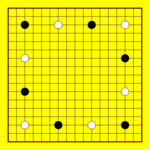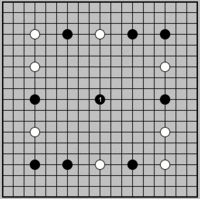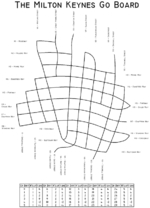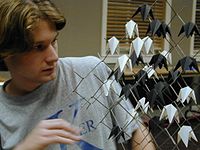







There are many variations of the simple rules of Go. Some are ancient digressions, while other are modern deviations. They are often side events at tournaments, for example, the U.S. Go Congress holds a "Crazy Go" event every year.
The difficulty in defining the rules of Go has led to the creation of many subtly different rulesets. They vary in areas like scoring method, ko, suicide, handicap placement, and how neutral points are dealt with at the end. These differences are usually small enough to maintain the character and strategy of the game, and are typically not considered variants. Different rulesets are explained in Rules of Go.
In some of the examples below, the effects of rule differences on actual play are minor, but the tactical consequences are substantial.
 The starting position for Tibetan Go
The starting position for Tibetan GoTibetan Go is played on a 17x17 board, and starts with six stones (called Bo) from each color placed on the third line as shown. White makes the first move. There is a unique ko rule: a stone may not be played at an intersection where the opponent has just removed a stone. This ko rule is so different from other major rulesets that it alone significantly changes the character of the game. For instance, snapbacks must be delayed by at least one move, allowing an opponent the chance to create life. Finally, a player who occupies or surrounds all four corner points (the 1-1 points) receives a bonus of 40 points, and if he controls the center point also, he receives a further bonus of 10 points.
Read main article: Sunjang baduk
 The starting position for Sunjang Baduk
The starting position for Sunjang BadukSunjang baduk is a different form of Go (baduk) that evolved in Korea. It has been played since at least the 7th century. Its most distinctive feature is the prescribed opening. The starting position dictates the placement of 16 stones (8 black, 8 white) as shown, and the first move is prescribed for Black at the center of the board.
At the end of the game, stones inside friendly territory, which are irrelevant to boundary definition, are removed before counting territory.
In another Korean variant, bangneki, the players wager on the outcome of the game. A fixed stake ("bang") is paid for every ten points on the board by which the loser is beaten.
Read main article: Batoo
Batoo is a modern Korean variant. The name stems from a combination of the Korean words baduk and juntoo (“battle”). It is played entirely in cyberspace, and differs from standard Go in a number of ways, most noticeably in the way in which certain areas of the board are worth different points values. The other principal difference is that both players place three stones before the game begins, and may also place a special “hidden stone”, which affects the board as a regular stone but is invisible to the opponent. Batoo became a short-lived fad among young people in Korea around 2011.
Read main article: Capture Go
The first player to capture a stone wins. It was invented by Japanese professional Yasutoshi Yasuda, who describes it in his book Go As Communication. Yasuda was inspired by the need for a medium to address the problem of bullying in Japan, but soon found that "First Capture" also works as an activity for senior citizens and even developmentally delayed individuals. He sees it as a game in its own right, not just as a prelude to Go, but also as a way to introduce simple concepts that lead to Go. For the latter purpose, he recommends progressing to "Most Capture", in which the player capturing the most stones wins. This variation is often called Atari Go in the West, where it is becoming increasingly popular as a preliminary means of introducing Go itself to beginners, since, afterward, it is natural to introduce the idea of capturing territory, not just the opponent's stones.
In Stoical Go, invented by abstract game designer Luis Bolaños Mures, standard ko rules don't apply. Instead, it's illegal to make a capture if your opponent made a capture on his previous move. All other rules are the same as in Go. Suicide of one or more stones is not allowed, and area scoring is used.
All known forced Go cycles are impossible with this rule. The nature of the rule itself suggests that forced cycles are either impossible or astronomically rarer than they are in Go when the superko rule is not used.
Ko fights proceed in a similar manner to those of Go, with the difference that captures and moves answered by captures aren't valid ko threats. On the other hand, snapbacks are not possible, as it is necessary to make a ko threat before any consecutive capture occurs.
Invented by Elwyn Ralph Berlekamp, Coupon Go compels the players to make quantitative decisions.
Environmental Go, invented by Elwyn Berlekamp, adds an element of mathematical precision to the game. In lieu of playing a stone, a player may take the highest remaining card from a pack of cards valued in steps of ½ from ½ to 20: the player's score will be the territory captured, plus the total value of cards taken. In effect, the players participate in a downward auction for the number of points they think sente is worth at each stage in the game. The professional players Jiang Zhujiu and Rui Naiwei played the first Environmental Go game in April 1998. Since then the variant has seen little activity on the international scene.
Each player begins the game with a decided upon amount of time (no byoyomi). At the end of the game, when the score is counted, the number of seconds remaining on each player's clock is added to his or her respective score.
In Cards Go players draw from a pack of cards contain instructions to play one of a fixed set of commonly occurring shapes. If the said shape cannot be placed on the board, then an illegal move is deemed to have been played, which necessitates resignation.
 A game of Go with stones of different colors
A game of Go with stones of different colorsIn Multi-player Go, stones of different colors are used so that three or more players can play together. The rules must be somewhat altered to create balance in power, as those who play first (especially the first four, on a four-cornered board) have significant advantage.
There are various optional rules that enable cooperation between the players, e.g. division of captured stones among neighbors, or forming alliances for adding up territory points. A variant called parallel multiplayer go also exists, where the moves are announced simultaneously. If two moves overlap, they count as passes.
Paper and Pencil Go is a Go variant that can be played with just paper and pencil. Unlike standard Go, games played under these rules are guaranteed to end in a finite number of moves, and no ko rule is needed. Nothing is ever rubbed out. It differs from standard Go in the following ways:
(Conventional Go can also be played on paper by drawing circles of different colors. Captured stones are marked with a line. Then if the square is replayed, a smaller circle is placed inside the larger circle.)
Also named Tetromino Go. Devised by R. Wayne Schmittberger, each player is allowed to play up to four stones in a turn, provided they are solidly connected on adjacent points. (There are five four-stone patterns possible, two three-stone patterns, and one two-stone pattern, ignoring rotations and reflections.) There is no komi; Black is restricted on his first turn to playing no more than two stones. The winner is determined by Chinese scoring: occupied and surrounded points each count 1 point; captured stones do not have point value. The inventor suggests a 15x15 square-celled board using square-tiled pieces.
The first player forced to capture one or more stones or to make a suicide move loses.
In this variant, black is given a large handicap, and must prevent white from forming a stable group.
This involves two teams of players taking either the Black or the White stones. Each player in the team must play in turn, playing out of sequence will normally result in a small penalty (usually three prisoners). Partners may not consult on how to play, or engage in any form of signaling. Communication between partners may only take the following forms listed below.
Pair Go is a gender specific form of Rengo, calling for teams composed of one male and one female member. It was popularised by the Japan Pair Go Association as a means of increasing female participation in the game. They hoped that this increase in itself would add a new appeal to the game. The Ricoh Cup, the annual professional Pair Go world championship debuted in 1994. The International Pair Go Association sponsors an annual amateur world championship in Tokyo in November, which has been running uninterrupted since 1989. They first introduced the variant to Europe at the 1992 European Congress in Canterbury, England. Amateur Pair Go tournaments have been held in the United States at U.S. Go Congresses since 2005 at least and in Denver, CO.
One (as a handicap) or both of the players cannot see the board in this variant. Therefore, they have to remember the whole position. This is considered much more difficult than playing blind chess. Indeed, most club standard players can play blind chess, but only professional players are able to complete a game of blind 19x19 Go.
Both players use stones of the same color. This variation is regarded as a useful tool for developing one's reading skills.
These variants are not purely strategic games, as the element of luck is quite important.
This game requires two players, a referee and three playing sets. Each player sees only his own board, while the referee can see them both and also has his own set. Players place stones on their boards, with no knowledge of what other players are doing. A referee keeps track of the game on the central board. If any player makes an illegal move, the referee informs him about it (some play that the referee says only that the move is illegal, while some, that the player is told whether the intersection is occupied or there is illegal ko capture). The player is allowed to make another move.
This is a crossover between rengo and shadow Go. There are two teams with two players each, a referee and five Go sets. The players move alternatingly as in rengo. Each player keeps track of their own moves on their own board; they are not informed about teammates' or opponents' moves. The referee keeps track of the complete game and informs a player if their move was illegal, in which case they can try again. The referee removes captured stones from all affected boards. Because of the asymmetry in information, this may be an undecidable game; which would mean that there is in principle no computer or algorithm that can tell from a given position who will win.
Although Go is most commonly played on a board with 19x19 lines, 9x9 and 13x13 boards are also available. They are used by beginners and by players who want a game that finishes more quickly. Due to flexibility of configuration, the two smaller sizes are more often played on the online Go servers such as KGS Go Server, and board sizes from 2x2 to 38x38 are also allowed.
 The Milton Keynes Goban
The Milton Keynes GobanThe annual Milton Keynes Go Tournament has a popular side-event that is played on a stylised map of Milton Keynes. Its non-conventional lattice presents some interesting possibilities.
Harald Schwarz invented a Go variant that is played on a circular lattice.
Toroidal is played on a two-dimensional doughnut shaped surface. It can be played on a computer app or simulated on a standard board, but requires imagination on the part of the players to perform an abstract join at the edges. Tactics become more elegant without the need for special border and corner cases (joseki) since a toroidal board has only "middle" space.
TriGo uses a triangular-grid goban, where each stone has up to six liberties. To compensate for this, there are several rule changes: ko and superko are limited in scope, komi is not used, and after the first stone is placed, every turn consists of placing two stones. After both players have passed a turn, the score is counted (the sum of captured stones and territory), and in the case of a draw the player passing first wins.
TriPlan, for three players, uses a triangular grid, where each stone has up to six liberties. Stones can be captured in two ways. If one player's stones are surrounded by those of one opponent, the surrounding player captures them and counts them as points at the end of the game. If one player's stones are surrounded by those of both opponents, they must be played as the surrounded player's next turn. If a player resigns, the two other players will determine who alone makes it against the other two. That player will play alone, who wants to have achieved a higher minimum score at the end of the game. At the end all captured stones and all stones on the board are counted. If the player reach his achieved goal, he wins. If he don't reach the goal, the other two win the game. If there was no resign, it wins the player with the most points.
Other 2D variants can also be performed with edges joined in three other ways, resulting in a topological sphere, Klein bottle or real projective plane. Multiple boards can be used to form other Riemann surfaces.
 Diamond Go
Diamond GoAlak is a Go-like game restricted to a single spatial dimension. Go can be extended to three dimensions. One example is Diamond Go, which uses the structure of a carbon diamond crystal lattice. With many such Go variants, the nature of the game changes dramatically the standard 4-connectivity of the points is changed, however, Diamond Go maintains this connectivity. Another example is Margo, by Cameron Browne, a variant played with marbles that can be stacked on top of one another.
A program called Freed Go can be used to play with boards with generic topology. It has embedded 11 different boards, either three-dimensional shapes (including cube, sphere, cylinder, diamond, torus and Möbius strip) or flat fields with points connected to three, five or six neighboring points, but it's also possible to create custom boards.